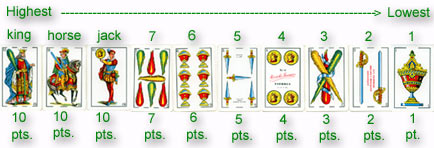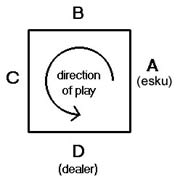Mus
Players and Cards
Object of the Game
Vocabulary and Pronunciation
Deal and Mus
The four ways of comparing hands
 Haundia
Haundia
Txikia
Pareak
Jokua
The Betting
Betting on Haundia and Txikia
Betting on Pareak and Jokua
Hor Dago
The Showdown and Scoring Haundia and Txikia
Scoring Pareak
Scoring Jokua or Puntuak
Keeping score - Tantoak and Hamarrekoak
Keinuak - the signs
NABO Official Tournament Rules
History of the Game
Ontario, Oregon Basque Club Tournament
Players and Cards
Mus is played by 4 players working as two teams. Partners sit opposite each other and play moves in a counter-clockwise direction. The player seated to the right of the dealer is the esku and is the first player to speak. The suits in Mus are cups, coins, swords and clubs. However, suits are irrelevant in mus. Each suit has an erregea or king (12), zaldia or horse (11), txanka or jack (10), 7, 6, 5, 4, 3, 2, and 1. Each card has the value of its corresponding number with the exception of the face cards which are all worth 10 points. If playing with another type of deck remove the 8s and 9s and 10s. The queen in the American deck substitutes the horse (zaldia).

Object of the Game
The first team to get 30 points wins (at NABO tournaments you play to 40). This is accomplished over the course of several hands. Score is kept with tantoak (little metallic garbanzos), real beans or other tokens. Players score points for having the best hand of cards in each of four categories: haundia (high), txikia (low), pareak (pairs) and jokua (game). Players can attempt to score additional points in any category by betting. The betting is carried out in a specific order, and cards are not revealed until all four betting rounds of the hand have been completed.
Deal and Mus
 The dealer shuffles, the player to dealer's left cuts, and the dealer deals the cards (counter-clockwise) one at a time until each player has four. Mus is a proposal that all four players should have a chance to improve their hands by discarding one or more cards. This can only happen if all four players agree. The players speak in turn starting with the esku. If all four agree to change cards by saying "Mus" the discard takes place as described below, but if any player disagrees by saying hasi, mintza or musik ez, there is no opportunity to discard and the game proceeds immediately to the first round of betting. If everyone said "Mus", then each player in turn, starting with the esku, discards from one to four cards face down and is dealt an equal number of new cards. The players look at their new hands and there is another opportunity to propose "Mus" as before. If the players keep on agreeing to Mus, eventually the dealer will run out of cards. If this happens while more than one player requires cards, all the discards are shuffled to form a new stock to deal from. If the cards run out while only one player is short, then the cards excluding that player's discard are shuffled to make a new stock.
The dealer shuffles, the player to dealer's left cuts, and the dealer deals the cards (counter-clockwise) one at a time until each player has four. Mus is a proposal that all four players should have a chance to improve their hands by discarding one or more cards. This can only happen if all four players agree. The players speak in turn starting with the esku. If all four agree to change cards by saying "Mus" the discard takes place as described below, but if any player disagrees by saying hasi, mintza or musik ez, there is no opportunity to discard and the game proceeds immediately to the first round of betting. If everyone said "Mus", then each player in turn, starting with the esku, discards from one to four cards face down and is dealt an equal number of new cards. The players look at their new hands and there is another opportunity to propose "Mus" as before. If the players keep on agreeing to Mus, eventually the dealer will run out of cards. If this happens while more than one player requires cards, all the discards are shuffled to form a new stock to deal from. If the cards run out while only one player is short, then the cards excluding that player's discard are shuffled to make a new stock.
The Four Ways of Comparing Hands
The players compete to establish who has the best cards in each of four different categories, Haundia, Txikia, Pareak and Jokua, which will now be explained. Note: In all cases, if two hands are otherwise equal the winner is the esku, or the earlier player after the esku in counter-clockwise order. In the diagram, in case of equality, A beats B who beats C who beats D.
Haundia (High)
This is won by the hand with the highest cards. In comparing two hands the cards in each are arranged in descending order. The hand with the higher first card wins, or if these are equal the hand with the higher second card, or if these are equal too, the higher third card, or if the first three cards are tied the higher fourth card. In the absence of betting on Haundia, the side with the best Haundia wins one tanto.
Txikia (Low)
This is won by the lowest hand. The cards are arranged in ascending order and the hand with the lower first card wins, or if these are equal the lower second card, and so on. In the absence of betting on Txikia, the side with the best Txikia wins one tanto.
Pareak (Pairs)
These are sets of two or more cards of equal rank. There are three types. In ascending order they are:
Parea
Two cards of equal rank and two of different ranks - such as King-Jack-Jack-5. The hand with the higher pair wins, and the other two cards are irrelevant even if the pairs are equal. Therefore between 7-7-4-3 and King-Horse-7-7, the winner is the esku or the earliest player after the esku in counter-clockwise order.
Mediak
Three cards of equal rank and one card of a different rank, such as King-
King-King-6. The hand with the higher set of three cards wins, and the rank of the fourth card is irrelevant.
Dobleak
Two pairs of cards of equal rank, such as Horse-Horse-5-5. There is no special significance if all four cards are of the same rank - this just counts as two equal pairs. If more than one player has dobleak, the higher pair is compared first, then the lower pair. So Horse-Horse-5-5 beats Jack-Jack-Jack-Jack because the Horse is higher than the Jack, and Horse-Horse-5-5 beats Horse-Horse-4-4 because the 5 beats the 4.
Any dobleak beats any mediak, and any mediak beats any parea, irrespective of the ranks of the cards.
If there is no betting on the pareak, whoever has the best hand scores for her own and her partner's hand as follows:
parea |
1 tanto |
mediak |
2 tanto |
dobleak |
3 tanto |
and the other side scores nothing for any pareak they may hold.
Jokua (Game)
For the purposes of Jokua, the cards have point values as follows:
King, Horse, Jack |
10 points |
7 |
7 points |
6 |
6 points |
5 |
5 points |
4 |
4 points |
Ace |
1 point |
In other words face cards are worth 10, and other cards are face value.
For Jokua, you simply add up the point values of the cards in your hand. To have Jokua you must have at least 31 points.
The best Jokua is a hand of exactly 31 points. The next best is 32. Then come in descending order 40, 37, 36, 35, 34 and 33 (potolo), which is the lowest Jokua. If your cards total 30 or less you don't have a Jokua. Note that a 31 point Jokua held by the Esku is unbeatable.
If there is no betting on Jokua, then the side with the best Jokua scores for both their hands: 3 tantoak for Jokua of 31 and 2 tantoak for any other Jokua. The other side scores nothing.
If no one has Jokua, then you compete instead for the best Puntuak, which is a hand totaling 30 or fewer points. The highest Puntuak is a hand with 30 points, then 29, 28 and so on, down to 4, which is the worst. If no one bets, the player with the best Puntuak gets 1 tanto.
Betting
There is a round of betting for each category of hand: Haundia, Txikia, Pareak, Jokua, and they must be taken in strict order. Each round is begun by the esku(the player to dealer's right). The esku may announce each round so that the players know what they are currently betting on, but this is not really necessary if the players are awake because the four rounds always occur in sequence.
Betting on Haundia and Txikia
Each round of betting is begun by the Esku , who may either pass (paso) or bet (enbido). If the esku passes, the next player in counter-clockwise order may pass or bet, and so on round the table. If all four players pass, there is no betting in that category, and the esku begins the round of betting for the next category.
A bet is a proposal to stake some number of tantoak, at least 2, on the outcome of the category. If no number is mentioned, 2 is assumed, so if the esku starts the first round of betting by just saying "I bet - enbido", it is a proposal to stake 2 tantoak on the Haundia. It is also possible to bet a higher number by saying for example "enbido 5", or "enbido 20".
If someone bets, the opposing team has three options. They must decide whether to:
-
fold (tira) - conceding that the betting side wins that category, irrespective of who has the best cards, but losing only one tanto;
-
see (edoki - agreeing that the side with the best cards will win the amount bet; or
-
raise (beste 2 or 2 gehiago) - proposing to raise the stake further (2 or any amount).
Either partner may speak; if they disagree, in general the more aggressive action prevails (raise rather than see, see rather than fold). However, it is possible for a player to overrule partner by using the plural: "we fold" or "we see". If the opponents fold in response to the first bet of a round, the side that bet immediately win one tanto for "tira". If the opponents see the bet, the scoring is deferred to the showdown at the end of the hand. Raising is a proposal to increase the stake further, by at least 2. If no number is stated, 2 is assumed, but it is possible to raise by any higher amount. It is helpful to state the amount of the raise and the new total - e.g. "I bet 3", "I raise 5, making 8". After a raise, the other side now has to decide whether to fold, see or raise further, and so on.
The round of betting continues until one side or the other either folds or sees the last bet or raise. If one side folds, the other side immediately takes the number of tantoak previously staked (example: A says "I bet"; B says "I raise, making 4"; A says "I raise 16, making 20"; B says "We fold". A and C immediately take 4 tantoak.) If the last bet or raise is seen, then in the showdown, the side with the best cards in that category will win the agreed stake.
Betting on Pareak and Jokua
The betting procedure described above applies to the first two rounds, haundiaand txikia. The procedure for pareak and jokua is slightly different.
Pareak: Before any betting on Pareak can begin, each of the four players must announce in turn (truthfully) whether they actually have Pareak by saying "bai" (yes) or "ez" (no).
-
If at least one player from each partnership says "bai", then there follows a round of betting on the Pareak, using the same procedure as for haundia and Txikia.
-
If both players of one partnership say "ez", but one or both of the other partnership say "bai", then the side with Pareak will score for them at the end, but there is no betting.
-
If all four players say "ez", then there will be no score for Pareak at all on that hand, and of course no betting.
Jokua: Before any betting on Jokua can begin, each of the four players in turn must say whether they have Jokua - that is whether their cards total at least 31 points.
-
If at least one player from each partnership says "bai", then there follows a round of betting on Jokua, using the same procedure as for haundiaand txikia.
-
If both players of one partnership say "ez", but one or both of the other partnership say "bai", then the side with Jokua will score for them at the end, but there is no betting.
-
If all four players say "ez", then there will be no score for Jokua, but instead, there is a competiton for puntuak. So in this case there is a round of betting on who has the best Puntuak, using the same procedure as for Haundia and Txikia.
Hor Dago
Hor dago (literally “there it is”) is a special bet - a proposal for an immediate showdown, staking the outcome of the whole game on the current category. During any of the four rounds, a player instead of betting or raising in the normal way may say Hor dago. The opponents must then either fold - conceding the loss of that category, or see it, in which case there the cards are shown and the game is decided.
Here is an example. In the first round of betting A, B and C pass, D says "enbido 5" and A says "edoki". So haundia will be worth 1 hamarreko(equivalent to 5 tantoak). Second round of betting (Txikia): A says "enbido"; B says "beste 4, making 6"; C says "Hor dago". B and D must now either fold or see. If they fold, A and C take a total of 6 (1 hamarreko and 1 tantoa). If they see it, whichever side has the best Txikia wins the game immediately (and the 1 hamarreko for haundia become irrelevant, even if they would have been enough to decide the game).
It is of course, possible to say Hor dago instead of the first bet of a round. If you do this and the opponents fold, you get just one tanto, for "tira".
The Showdown and Scoring
After the end of the last round of betting (on Jokua or Puntuak), all four players show their cards, and the hand is scored. Again this is done in the order Haundia, Txikia, Pareak, Jokua. The order of scoring is important because it is possible for the game to be won by one side reaching 30 points part way through the scoring process.
Scoring
If either side folded during the corresponding betting round there is no further score - the winners have already had their tantoak. If for example A and C bet on Txikia and B and D folded, then even if B or D actually turns out to have the best Txikia there is no score for this, as they have given up their right to win Txikia by folding (A and C have bluffed successfully).
If the betting round ended with one side seeing the other, or if everyone passed, then the hands are compared to see which individual player has the best combination of that type, and that player's team wins the agreed amount of tantoak (or one tanto if everyone passed).
Example (for haundia): A (esku) has 7-7-2-ace; B has king-king-jack-ace; Chas king-king-jack-ace; D has horse-horse-horse-6. Then B's hand is best (B and C have equal cards but B is earlier in the order of play), so B and D win the stake for haundia.
Scoring Pareak
If one side folded in the betting round, then the side which made the final bet or raise automatically wins, even if their actual Pareak are not as good as the side that folded. The winning side will already have won one or more tanto for this in the betting round, but now in addition they score the appropriate amount of tantoak for the Pareak in their hands, that is: 1 for parea; 2 for mediak; 3 for dobleak. They must have at least one example of Pareak between them or they were not allowed to have bet. If both partners have Pareak then both score.
If the betting round ended with one side seeing the other, then the hands are compared to see which individual player has the best Pareak, and that player's team wins the agreed stake for the Pareak, plus the value of the Pareak in both their hands.
If there was no betting, the hands are compared as above, and the winning player's team just score for the Pareak in both their hands. Of course if no one has Pareak at all then no one scores.
For example: A (esku) has 7-7-ace-ace; B has king-king-jack-ace; C has king-king-jack-ace; D has horse-horse-horse-6. A's hand is best (dobleak), so A and C score for A's dobleak and C's parea. Assuming that A and C have bet 4 and B and D have seen it then A and C win a total of 8 tantoak (3 + 1 + 4). Alternatively if A and C bet 4, B and D raised by 6 making 10, and A and C then folded, B and D would now win 3 tantoak (for B's parea and D's mediak) in addition to the 4 they won during the betting round when A and C folded.
Scoring Jokua or Puntuak
The principle is similar to scoring Pareak. If one side folded during the betting, then the other side has already won, and has already taken some tantoak. In addition to this, if the betting was on Jokua, both members of the winning team score the appropriate amount of tantoak for the Jokua in their hands (3 for 31, 2 for any other Jokua). If the betting was on the Puntuak, they just take one additional tanto for winning the Puntuak.
If the betting round ended with one side seeing the other, then the hands are compared to see which individual player has the best cards. In the case of Jokua, the winning player's team wins the agreed stake, plus the value of the Jokua in both their hands. In the case of Puntuak, the winning player's team wins the agreed stake plus just one extra tanto for winning the Puntuak.
If there was no betting, but at least one player had Jokua, then the team of the player with the best Jokua scores for this and for her partner's Jokua if any. If no one had Jokua, then the team of the player with the best Puntuak scores one point.
This is done with small metallic garbanzos, real beans, pebbles, or other convenient small objects. You need 18 of them. They all start in a saucer in the middle of the table, and are taken and placed in front of the four players to represent the score. Each partnership decides who will keep the ones (simply referred to as tantoa) and who will keep the fives (hamarrekoak).
Note: in Basque, the word hamarreko, (oddly )literally means "of ten" rather than "of five".
When a partnership wins one or more tanto, the player keeping the ones simply takes the appropriate number from the saucer and places them in front of himself. When he has five, he gives one to his partner, who is keeping the fives (hamarrekoak), and puts the other four back in the saucer. When taking or moving tantoak you should always tell the opponents how many you are taking, and why.
Adapted from “Mus” written by John McLeod. From: The Card Games Web Site by John McLeod ([email protected]).© John McLeod, 1995, 2003 Last updated 18th January 2004. Adaptation by Ontario Basque Club.History of the Game- Larramendi (1754)
The oldest written reference of the game Mus appeared in Corografía de Guipuzcoa by Jesuit priest Father Manuel Larramendi in 1754. He described the game from what he saw in his excursions through the mountains and farmhouses of Gipuzkoa. Larramendi wrote about mus as a game played usually by four, with four cards each and with four distinctive parts: "andi, chiquia, parejac, jocoa" (big, small, pairs, game – Basque orthography had not yet been standardized.) He also makes a reference of the word mus or "musu" meaning lips or face and suggests that the name of the game could have derived from the facial gestures used while playing.
Larramendi suggests that the game of mus is as old as the cards themselves. We know that this is not quite the case, but it does speak to how well established the game was at that time. The age of the game is controversial and so is that of the cards themselves. The French attribute themselves with the invention of the deck of cards in 1392. However, in a document written in Vitoria-Gasteiz in 1334, the Knights of the order of "La Banda" are categorically prohibited from playing cards which tells, of course, that playing cards already existed..
Other important information given by father Larramendi is the two ways of playing mus. He talks about old mus and new mus. Contrary to common belief, the old mus was played with 8 kings and 8 aces, using the threes as kings and the twos as aces. The new mus is played using only 4 kings and 4 aces. The first type is played in Araba, Bizkaia and all over Spain. The other is preferred in Gipuzkoa, Nafarroa and the three provinces of Iparralde.
The game is usually played with the deck designed by Fournier and known as the Spanish deck, although it can be played with the French or poker deck discarding 8's, 9's and 10's. The cards go from 1 to 7 and the Jack, Horse or Queen and the King. Mus is divided into four distinctive parts:
Haundia |
consists of having the highest possible cards, preferably kings. |
Txikia |
is the opposite and having the low cards is desirable. |
Pareak |
formed by two of a kind, three of a kind called mediak, and two pairs or four of a kind called dobleak. |
Jokua |
consists of having 31 or more. The value of the cards is 10 points for face cards and their marked value for the rest. |
The rules of the game depend in many cases on who is at the table playing. The card factory Fournier of Vitoria-Gasteiz published some rules which include the use of 8 kings and the non-validity of the royal 31 (3 sevens and a face card.) However, in the world championships celebrated since 1978, the regulations include the use of 4 kings and the royal 31.
There is a strong case for the Basque origin of mus and the game remains very popular - If four Basques get together a mus game is organized. The game is played in North and South America, Australia and Europe. It is a game in which the players demonstrate ability, intelligence, cleverness, intuition, reasoning and decision making. It is a great pastime and one that requires more than pure luck to be able to win.











